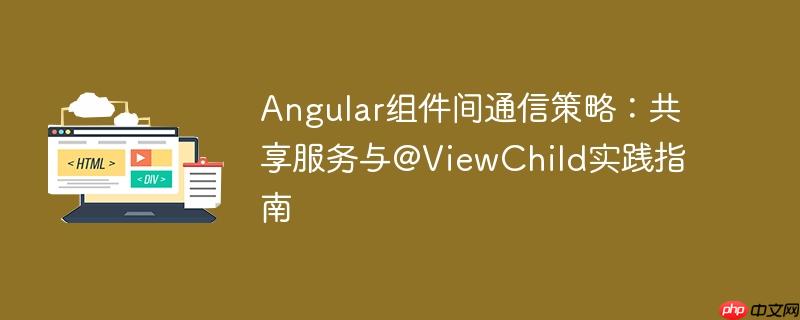
在angular应用开发中,组件间的数据或事件传递是常见需求。根据组件之间的关系(如父子、兄弟、无关),我们可以选择不同的通信策略。本文将重点介绍两种常用且有效的通信方式:基于共享服务的发布/订阅模式和基于@viewchild的直接调用模式。
当两个组件之间没有直接的父子关系,或者它们是兄弟组件时,使用共享服务是一种推荐的通信方式。这种方法通过一个独立的服务作为中央数据总线,实现了组件间的解耦通信。
共享服务通常利用RxJS的Subject或BehaviorSubject来管理数据流。发送组件通过服务调用next()方法发布数据,接收组件则通过服务订阅(subscribe())数据流,从而获取最新的数据。
共享服务 (main.service.ts)
import { Injectable } from '@angular/core';
import { BehaviorSubject, Observable } from 'rxjs';
@Injectable({
providedIn: 'root' // 确保服务在整个应用中是单例的
})
export class MainService {
// 使用 BehaviorSubject 存储消息,并提供一个初始值 "111"
private messageSource = new BehaviorSubject<string>("111");
// 暴露一个 Observable 供组件订阅,确保外部无法直接修改数据
currentMessage: Observable<string> = this.messageSource.asObservable();
constructor() { }
/**
* 发送消息的方法
* @param mess 要发送的字符串消息
*/
sendMessage(mess: string) {
this.messageSource.next(mess);
}
/**
* 接收消息的方法(实际上是返回可观察对象供订阅)
* @returns Observable<string> 消息的可观察对象
*/
receiveMessage(): Observable<string> {
return this.messageSource.asObservable();
}
}发送消息的组件 (first.component.ts)
import { Component, OnInit } from '@angular/core';
import { MainService } from '../main.service'; // 确保路径正确
@Component({
selector: 'app-first',
template: `
<button (click)="clickMe()">点击发送消息</button>
`,
// ... 其他配置
})
export class FirstComponent implements OnInit {
constructor(private mainService: MainService) { }
ngOnInit(): void {
// 可以在这里订阅,但通常发送组件不需要订阅自己发送的消息
}
/**
* 按钮点击事件,发送指定字符串消息
*/
clickMe() {
this.mainService.sendMessage("001");
console.log('FirstComponent: 消息 "001" 已发送');
}
}接收消息的组件 (second.component.ts)
import { Component, OnInit, OnDestroy } from '@angular/core';
import { MainService } from '../main.service'; // 确保路径正确
import { Subscription } from 'rxjs';
@Component({
selector: 'app-second',
template: `
<p>接收到的消息: {{ receivedMessage }}</p>
`,
// ... 其他配置
})
export class SecondComponent implements OnInit, OnDestroy {
clickEventSubscription: Subscription;
receivedMessage: string = ''; // 用于在模板中显示接收到的消息
constructor(private mainService: MainService) { }
ngOnInit(): void {
// 订阅消息流
this.clickEventSubscription = this.mainService.receiveMessage().subscribe(message => {
this.toggle(message); // 调用处理消息的函数
});
}
/**
* 处理接收到的消息
* @param state 接收到的字符串消息
*/
public toggle(state: string) {
console.log('SecondComponent: 接收到消息:', state);
this.receivedMessage = state; // 更新组件属性以在模板中显示
}
ngOnDestroy(): void {
// 组件销毁时取消订阅,防止内存泄漏
if (this.clickEventSubscription) {
this.clickEventSubscription.unsubscribe();
}
}
}当存在明确的父子组件关系时,父组件可以通过@ViewChild装饰器直接获取子组件的实例,从而调用子组件的方法或访问其属性。
@ViewChild装饰器允许父组件在模板中引用一个子组件实例,并将其注入到父组件的类属性中。一旦获取到子组件实例,父组件就可以像操作普通对象一样直接调用子组件的方法。
父组件 (first.component.ts)
import { Component, OnInit, ViewChild, AfterViewInit } from '@angular/core';
import { SecondComponent } from '../second/second.component'; // 导入子组件
@Component({
selector: 'app-first',
template: `
<button (click)="clickMe()">点击调用子组件方法</button>
<app-second></app-second> <!-- 确保子组件在模板中被渲染 -->
`,
// ... 其他配置
})
export class FirstComponent implements OnInit, AfterViewInit {
// 使用 @ViewChild 引用子组件实例
// 'secondChildView' 是父组件中的属性名
// 'SecondComponent' 是子组件的类名
@ViewChild(SecondComponent) secondChildView!: SecondComponent;
constructor() { }
ngOnInit(): void {
// 初始化逻辑
}
ngAfterViewInit(): void {
// @ViewChild 引用在 ngAfterViewInit 生命周期钩子之后才可用
// 在这里可以进行一些初始的子组件操作,但对于点击事件触发的,直接在事件处理函数中调用即可
if (this.secondChildView) {
console.log('子组件实例已准备好:', this.secondChildView);
}
}
/**
* 按钮点击事件,直接调用子组件的 toggle 方法
*/
clickMe() {
if (this.secondChildView) {
this.secondChildView.toggle('001'); // 直接调用子组件的 toggle 方法并传递参数
console.log('FirstComponent: 已通过 @ViewChild 调用 SecondComponent 的 toggle 方法');
} else {
console.error('SecondComponent 实例未找到!');
}
}
}子组件 (second.component.ts)
import { Component, OnInit } from '@angular/core';
@Component({
selector: 'app-second',
template: `
<p>子组件接收到的状态: {{ receivedState }}</p>
`,
// ... 其他配置
})
export class SecondComponent implements OnInit {
receivedState: string = '';
constructor() { }
ngOnInit(): void {
// 初始化逻辑
}
/**
* 子组件暴露给父组件调用的方法
* @param state 父组件传递的字符串状态
*/
public toggle(state: string) {
console.log('SecondComponent: toggle 方法被调用,接收到状态:', state);
this.receivedState = state; // 更新属性以在模板中显示
}
}选择哪种通信策略取决于组件之间的关系和通信的复杂性:
Angular提供了多种灵活的组件间通信机制。理解并选择正确的策略是构建可维护、可扩展应用的关键:
通过合理运用这些通信策略,开发者可以有效地管理Angular应用中的数据流,构建出结构清晰、功能强大的Web应用。
以上就是Angular组件间通信策略:共享服务与@ViewChild实践指南的详细内容,更多请关注php中文网其它相关文章!

每个人都需要一台速度更快、更稳定的 PC。随着时间的推移,垃圾文件、旧注册表数据和不必要的后台进程会占用资源并降低性能。幸运的是,许多工具可以让 Windows 保持平稳运行。

Copyright 2014-2025 https://www.php.cn/ All Rights Reserved | php.cn | 湘ICP备2023035733号